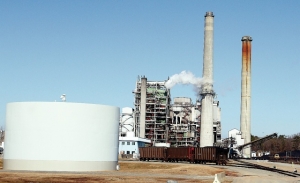Plant is now up and running
By Steve Herring
Published in News on January 4, 2013 1:46 PM

News-Argus file photo
Lee energy plant west of Goldsboro is seen in September. The smokestacks will be torn down now that the plant has converted from coal to natural gas to produce electricity.
A recently completed $900 million modernization project at the Progress Energy H.F. Lee Plant began commercial operation this week.
The 920-megawatt plant is now using a natural gas combined-cycle design that is more efficient than the old coal-fired units. It is being fed by a new $85 million 32-mile gas pipeline that Piedmont Natural Gas completed in June.
Along with providing natural gas for the plant, the new pipeline also expands the availability of natural gas in the area.
The projects were first announced in August 2009 and ground was broken in September 2010 just off Black Jack Church Road. Progress Energy has since merged with Duke Energy.
Located on the Neuse River just west of Goldsboro, the new facility, and the five combustion turbines at the existing Wayne County Energy Complex, have been renamed the H.F. Lee Energy Complex.
With the addition, the plant will have a total generation capacity of 1,800 megawatts.
About 85 people were employed at the H.F. Lee Plant, but it is expected that 47 employees will operate the new facility. Company officials have said they will work to find employees other positions within the company.
This past fall Progress Energy Carolinas retired the Lee Plant's three coal units -- built in 1951, 1952 and 1962 --and the four oil-fueled combustion turbines.
A timetable has not been announced, but the old plant that has been in operation since 1951 will be dismantled, including the smokestacks that have been part of the landscape for more than 60 years.
The coal ash pond at the site will be capped and monitored.
According to company officials, the new plant will realize a 60-percent reduction in carbon emissions, a 95-percent reduction in nitrogen oxides, and an almost 100-percent reduction in mercury and sulfur dioxide.
Also, while larger than the old facility, the new one will require considerably less water, company officials said. It will do so by recapturing, instead of venting, hot exhaust gas to create steam to turn the turbines to create more energy out of the same amount of fuel.
Two other new power plants, representing a combined investment of nearly $3.65 billion, began serving North Carolina customers at the end of 2012.
All three new plants were completed within budget, company officials said.
Cliffside Steam Station Unit 6 in Mooresboro reached commercial operation Dec. 30 and provides 825 megawatts. This state-of-the-art coal unit employs an innovative combination of air quality controls to remove 99 percent of sulfur dioxide, 90 percent of nitrogen oxides and 90 percent of mercury. Its high efficiency also means it burns less coal per megawatt-hour than most other coal units in the nation.
Also new online is the Dan River Combined Cycle Station in Eden with 620 megawatts of natural gas-fueled generation. This facility reached commercial operation Dec. 10.
In addition to investing nearly $6 billion in new plants since 2007 and retiring as much as 6,800 megawatts of older coal capacity, Duke Energy has invested another $7.5 billion for plant upgrades to reduce emissions across its service area.
These investments have reduced the regulated fleet's emissions of sulfur dioxide by 74 percent and nitrogen oxides by 57 percent since 2005.
Construction is also under way at the 625-megawatt natural gas combined-cycle facility at the Sutton Plant near Wilmington where 575 megawatts of older coal-fired generation will be retired. The new gas plant is scheduled to be commercially available by the end of the year.
